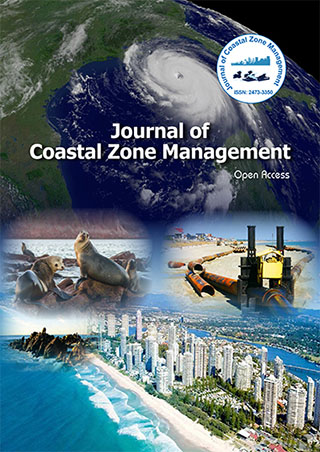Indexed In
- SafetyLit
- RefSeek
- Hamdard University
- EBSCO A-Z
- OCLC- WorldCat
- Publons
Useful Links
Share This Page
Journal Flyer

Open Access Journals
- Agri and Aquaculture
- Biochemistry
- Bioinformatics & Systems Biology
- Business & Management
- Chemistry
- Clinical Sciences
- Engineering
- Food & Nutrition
- General Science
- Genetics & Molecular Biology
- Immunology & Microbiology
- Medical Sciences
- Neuroscience & Psychology
- Nursing & Health Care
- Pharmaceutical Sciences
Perspective - (2025) Volume 28, Issue 1
Socio-Economic Implications of Coastal Erosion: An Interdisciplinary Analysis
Seon Li*Received: 27-Apr-2024, Manuscript No. JCZM-24-25570; Editor assigned: 02-May-2024, Pre QC No. JCZM-24-25570 (PQ); Reviewed: 16-May-2024, QC No. JCZM-24-25570; Revised: 13-Jan-2025, Manuscript No. JCZM-24-25570 (R); Published: 20-Jan-2025, DOI: 10.35248/2473-3350.25.28.661
Introduction
Coastal erosion is not merely an environmental issue but also a socio economic challenge with far reaching implications for coastal communities, economies and ecosystems. An interdisciplinary analysis that integrates perspectives from environmental science, economics, sociology and policy studies is essential for understanding the complex socio economic dynamics of coastal erosion and developing effective strategies for mitigation and adaptation.
At its core, coastal erosion threatens the socio-economic wellbeing of coastal communities by compromising coastal infrastructure, diminishing property values and disrupting livelihoods. As coastlines retreat and shorelines erode, valuable coastal properties, including homes, businesses and tourist facilities, are increasingly vulnerable to damage and loss. Infrastructure such as roads, bridges and utilities are also at risk, leading to disruptions in transportation networks and essential services.
Description
The socio-economic impacts of coastal erosion extend beyond direct property damage to encompass broader economic sectors, including tourism, fisheries and agriculture. Coastal tourism, a significant source of revenue for many coastal regions, suffers from erosion-induced beach loss and degradation, resulting in reduced visitor numbers, loss of revenue and job insecurity. Similarly, coastal fisheries and aquaculture operations are adversely affected by habitat loss and changes in water quality, leading to declines in fish stocks and livelihoods.
Moreover, coastal erosion exacerbates existing socio-economic inequalities by disproportionately affecting vulnerable and marginalized communities. Low-income populations living in coastal areas often lack the resources and adaptive capacity to cope with erosion-induced displacement, loss of housing and economic hardship. Indigenous communities, in particular, face unique socio-cultural challenges as erosion threatens ancestral lands, cultural heritage sites and traditional livelihoods tied to coastal resources.
An interdisciplinary analysis of the socio-economic implications of coastal erosion must consider the complex interactions between environmental change, human behavior and policy responses. Economic valuation techniques, such as cost-benefit analysis and contingent valuation, help quantify the tangible and intangible costs of erosion-induced impacts on coastal communities and ecosystems. By assigning monetary values to ecosystem services, cultural assets and social welfare, researchers can inform decision-making and prioritize investments in erosion mitigation and adaptation measures.
Furthermore, sociological approaches shed light on the social dynamics of vulnerability and resilience in coastal communities, exploring how socio-cultural factors shape perceptions of risk, adaptive strategies and community responses to erosion. Participatory approaches, such as community-based adaptation and stakeholder engagement, empower local residents to contribute their knowledge, priorities and concerns to decisionmaking processes, fostering social cohesion and collective action in the face of erosion-induced challenges.
Policy analysis and governance studies provide insights into the institutional frameworks and governance mechanisms governing coastal management and erosion control. Effective policy responses to coastal erosion require integrated, multi-level governance approaches that engage stakeholders across sectors and scales, coordinate efforts between government agencies and incorporate scientific evidence and local knowledge into decision-making processes.
Conclusion
In conclusion, an interdisciplinary analysis of the socioeconomic implications of coastal erosion is essential for understanding the multifaceted nature of this complex issue and developing holistic strategies for mitigation and adaptation. By integrating perspectives from environmental science, economics, sociology and policy studies, we can better address the socioeconomic challenges posed by coastal erosion, promote sustainable development in coastal areas and enhance the resilience of coastal communities and ecosystems in the face of environmental change.
Citation: Li S (2025) Socio-Economic Implications of Coastal Erosion: An Interdisciplinary Analysis. J Coast Zone Manag. 28:661.
Copyright: © 2025 Seon Li. This is an open-access article distributed under the terms of the Creative Commons Attribution License, which permits unrestricted use, distribution and reproduction in any medium, provided the original author and source are credited.
